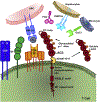Lymphocyte-activation gene 3 (LAG3): The next immune checkpoint receptor
- PMID: 31604537
- PMCID: PMC6920665
- DOI: 10.1016/j.smim.2019.101305
Lymphocyte-activation gene 3 (LAG3): The next immune checkpoint receptor
Abstract
Immune checkpoint therapy has revolutionized cancer treatment by blocking inhibitory pathways in T cells that limits the an effective anti-tumor immune response. Therapeutics targeting CTLA-4 and PD1/PDL1 have progressed to first line therapy in multiple tumor types with some patients exhibiting tumor regression or remission. However, the majority of patients do not benefit from checkpoint therapy emphasizing the need for alternative therapeutic options. Lymphocyte Activation Gene 3 (LAG3) or CD223 is expressed on multiple cell types including CD4+ and CD8+ T cells, and Tregs, and is required for optimal T cell regulation and homeostasis. Persistent antigen-stimulation in cancer or chronic infection leads to chronic LAG3 expression, promoting T cell exhaustion. Targeting LAG3 along with PD1 facilitates T cell reinvigoration. A substantial amount of pre-clinical data and mechanistic analysis has led to LAG3 being the third checkpoint to be targeted in the clinic with nearly a dozen therapeutics under investigation. In this review, we will discuss the structure, function and role of LAG3 in murine and human models of disease, including autoimmune and inflammatory diseases, chronic viral and parasitic infections, and cancer, emphasizing new advances in the development of LAG3-targeting immunotherapies for cancer that are currently in clinical trials.
Keywords: Autoimmunity; Cancer immunotherapy; Chronic viral infection; Immune checkpoint; Inhibitory receptor; LAG3.
Copyright © 2019 Elsevier Ltd. All rights reserved.
Conflict of interest statement
DISCLOSURE OF CONFLICT OF INTEREST
The authors declare competing financial interests. D.A.A.V and C.J.W. have submitted patents covering LAG3 that are licensed or pending and are entitled to a share in net income generated from licensing of these patent rights for commercial development.
Figures


References
-
- Gravitz L, Cancer immunotherapy, Nature 504(7480) (2013) S1. - PubMed
-
- Couzin-Frankel J, Breakthrough of the year 2013. Cancer immunotherapy, Science 342(6165) (2013) 1432–3. - PubMed
-
- Topalian SL, Hodi FS, Brahmer JR, Gettinger SN, Smith DC, McDermott DF, Powderly JD, Carvajal RD, Sosman JA, Atkins MB, Leming PD, Spigel DR, Antonia SJ, Horn L, Drake CG, Pardoll DM, Chen L, Sharfman WH, Anders RA, Taube JM, McMiller TL, Xu H, Korman AJ, Jure-Kunkel M, Agrawal S, McDonald D, Kollia GD, Gupta A, Wigginton JM, Sznol M, Safety, activity, and immune correlates of anti-PD-1 antibody in cancer, N Engl J Med 366(26) (2012) 2443–54. - PMC - PubMed
Publication types
MeSH terms
Substances
Grants and funding
LinkOut - more resources
Full Text Sources
Other Literature Sources
Research Materials

